Australian Unemployment: Causes, Issues, and Consequences Report
VerifiedAdded on 2020/04/07
|14
|3912
|403
Report
AI Summary
This report provides a comprehensive analysis of unemployment in Australia. It begins by defining unemployment and examining the unemployment rate trends from 2012 to 2017, supported by data analysis and graphical representations. The report delves into the various causes of unemployment, including increased production costs, economic downturns, technological advancements, and immigration. It also discusses the issues surrounding unemployment, such as the exclusion of discouraged workers and underemployment. Furthermore, the report explores the different types of unemployment, including cyclical, frictional, voluntary, structural, and seasonal. It also considers the distribution of unemployment across different states and age groups. Finally, the report examines the consequences of high unemployment rates and touches upon relevant government policies. The report aims to address the multifaceted nature of unemployment in Australia and its implications for the economy and workforce.
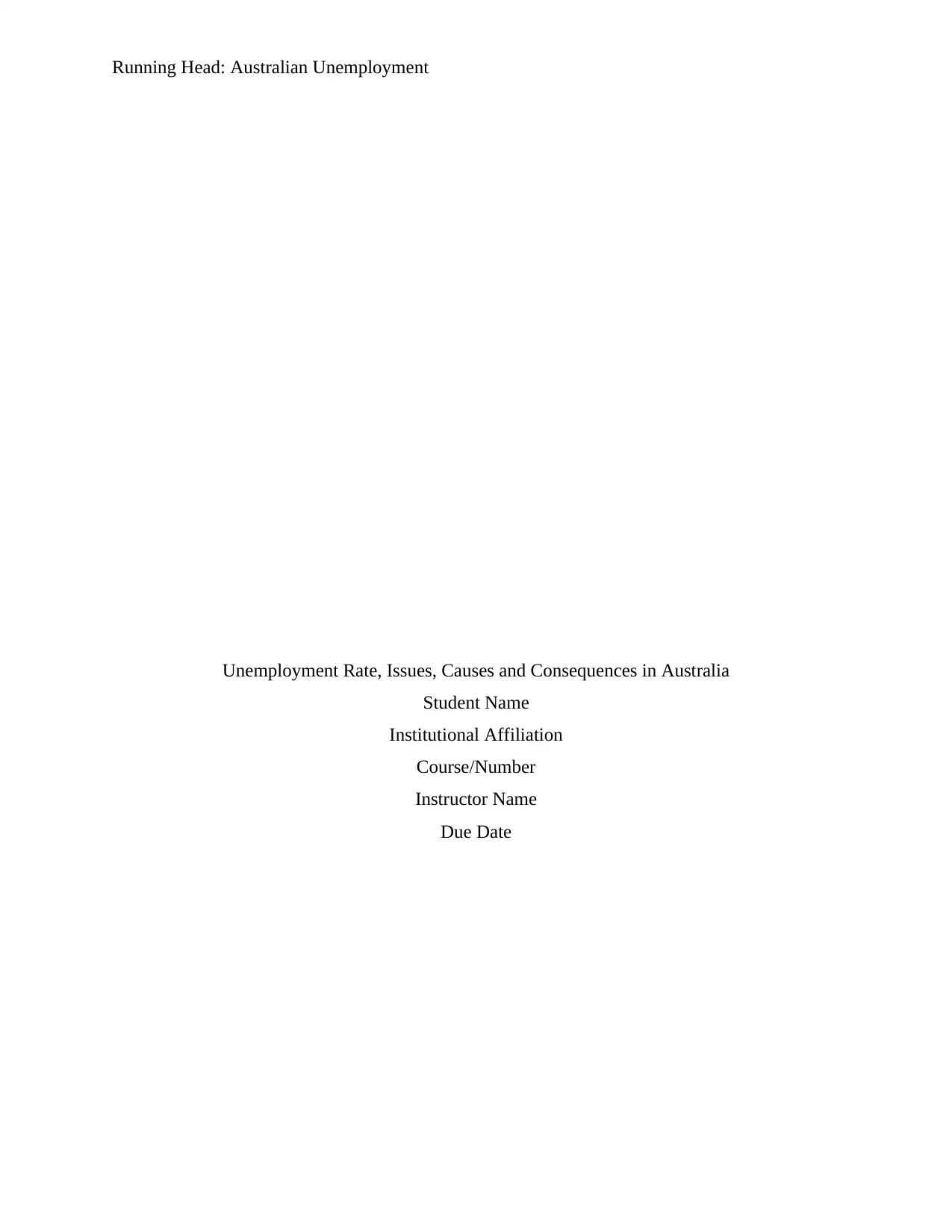
Running Head: Australian Unemployment
Unemployment Rate, Issues, Causes and Consequences in Australia
Student Name
Institutional Affiliation
Course/Number
Instructor Name
Due Date
Unemployment Rate, Issues, Causes and Consequences in Australia
Student Name
Institutional Affiliation
Course/Number
Instructor Name
Due Date
Paraphrase This Document
Need a fresh take? Get an instant paraphrase of this document with our AI Paraphraser
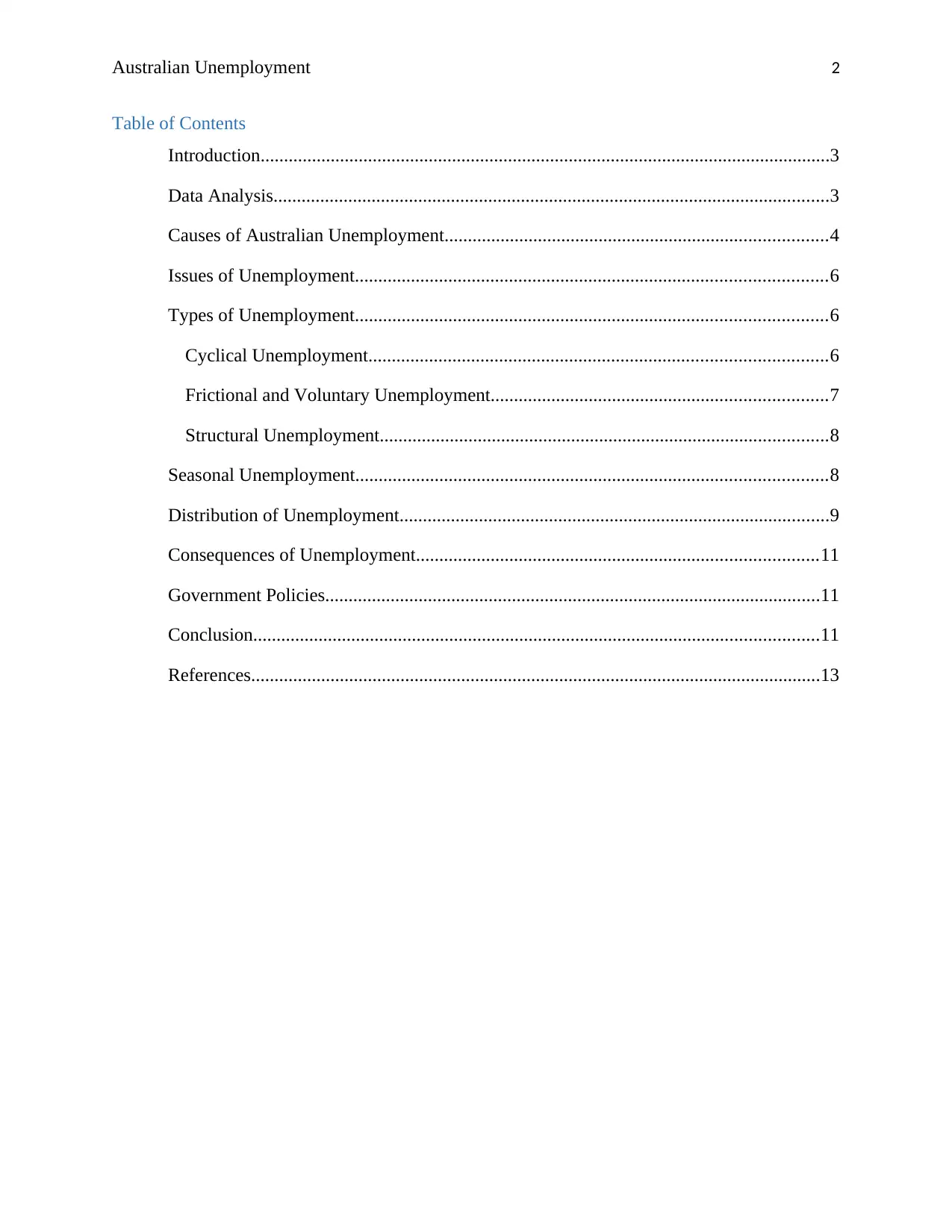
Australian Unemployment 2
Table of Contents
Introduction..........................................................................................................................3
Data Analysis.......................................................................................................................3
Causes of Australian Unemployment..................................................................................4
Issues of Unemployment.....................................................................................................6
Types of Unemployment.....................................................................................................6
Cyclical Unemployment..................................................................................................6
Frictional and Voluntary Unemployment........................................................................7
Structural Unemployment................................................................................................8
Seasonal Unemployment.....................................................................................................8
Distribution of Unemployment............................................................................................9
Consequences of Unemployment......................................................................................11
Government Policies..........................................................................................................11
Conclusion.........................................................................................................................11
References..........................................................................................................................13
Table of Contents
Introduction..........................................................................................................................3
Data Analysis.......................................................................................................................3
Causes of Australian Unemployment..................................................................................4
Issues of Unemployment.....................................................................................................6
Types of Unemployment.....................................................................................................6
Cyclical Unemployment..................................................................................................6
Frictional and Voluntary Unemployment........................................................................7
Structural Unemployment................................................................................................8
Seasonal Unemployment.....................................................................................................8
Distribution of Unemployment............................................................................................9
Consequences of Unemployment......................................................................................11
Government Policies..........................................................................................................11
Conclusion.........................................................................................................................11
References..........................................................................................................................13
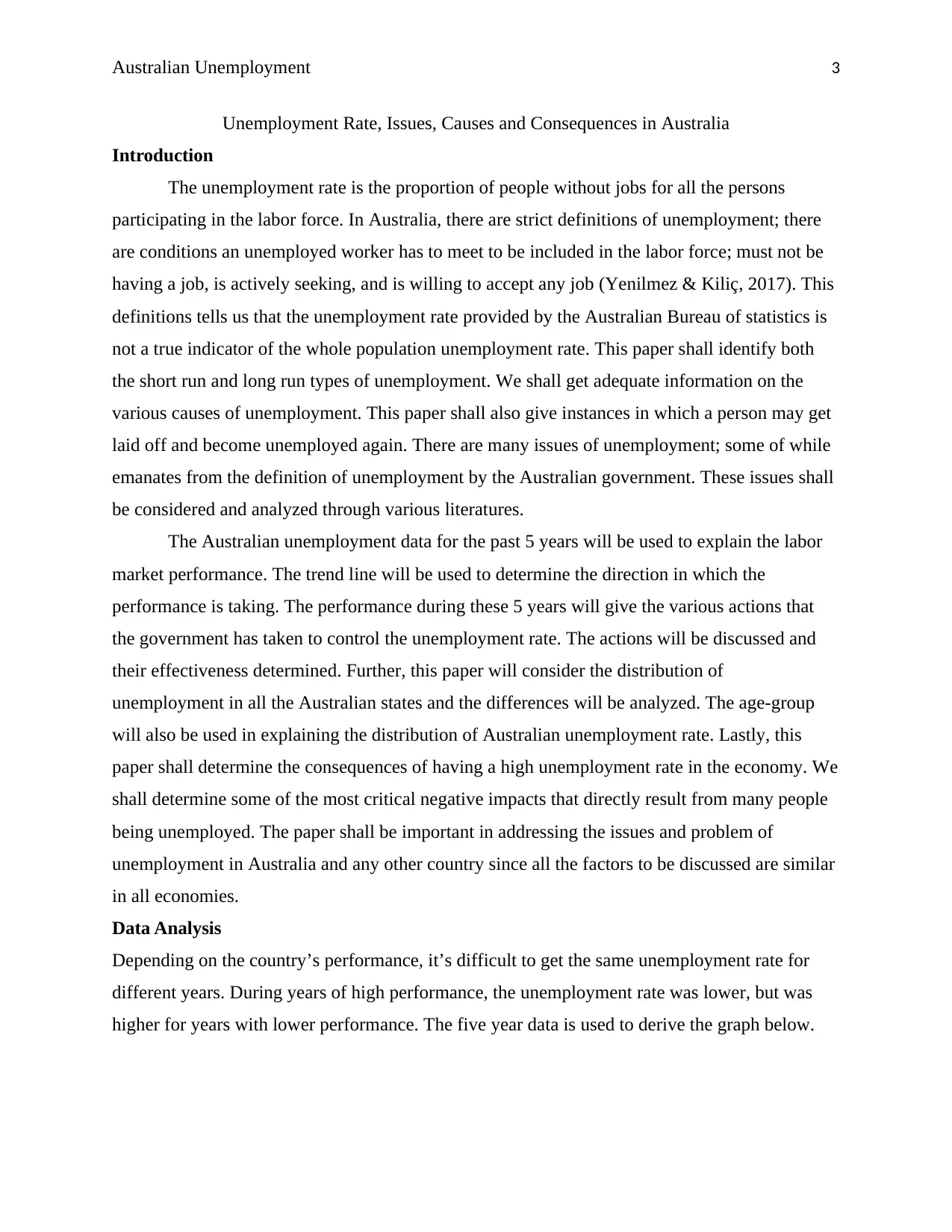
Australian Unemployment 3
Unemployment Rate, Issues, Causes and Consequences in Australia
Introduction
The unemployment rate is the proportion of people without jobs for all the persons
participating in the labor force. In Australia, there are strict definitions of unemployment; there
are conditions an unemployed worker has to meet to be included in the labor force; must not be
having a job, is actively seeking, and is willing to accept any job (Yenilmez & Kiliç, 2017) . This
definitions tells us that the unemployment rate provided by the Australian Bureau of statistics is
not a true indicator of the whole population unemployment rate. This paper shall identify both
the short run and long run types of unemployment. We shall get adequate information on the
various causes of unemployment. This paper shall also give instances in which a person may get
laid off and become unemployed again. There are many issues of unemployment; some of while
emanates from the definition of unemployment by the Australian government. These issues shall
be considered and analyzed through various literatures.
The Australian unemployment data for the past 5 years will be used to explain the labor
market performance. The trend line will be used to determine the direction in which the
performance is taking. The performance during these 5 years will give the various actions that
the government has taken to control the unemployment rate. The actions will be discussed and
their effectiveness determined. Further, this paper will consider the distribution of
unemployment in all the Australian states and the differences will be analyzed. The age-group
will also be used in explaining the distribution of Australian unemployment rate. Lastly, this
paper shall determine the consequences of having a high unemployment rate in the economy. We
shall determine some of the most critical negative impacts that directly result from many people
being unemployed. The paper shall be important in addressing the issues and problem of
unemployment in Australia and any other country since all the factors to be discussed are similar
in all economies.
Data Analysis
Depending on the country’s performance, it’s difficult to get the same unemployment rate for
different years. During years of high performance, the unemployment rate was lower, but was
higher for years with lower performance. The five year data is used to derive the graph below.
Unemployment Rate, Issues, Causes and Consequences in Australia
Introduction
The unemployment rate is the proportion of people without jobs for all the persons
participating in the labor force. In Australia, there are strict definitions of unemployment; there
are conditions an unemployed worker has to meet to be included in the labor force; must not be
having a job, is actively seeking, and is willing to accept any job (Yenilmez & Kiliç, 2017) . This
definitions tells us that the unemployment rate provided by the Australian Bureau of statistics is
not a true indicator of the whole population unemployment rate. This paper shall identify both
the short run and long run types of unemployment. We shall get adequate information on the
various causes of unemployment. This paper shall also give instances in which a person may get
laid off and become unemployed again. There are many issues of unemployment; some of while
emanates from the definition of unemployment by the Australian government. These issues shall
be considered and analyzed through various literatures.
The Australian unemployment data for the past 5 years will be used to explain the labor
market performance. The trend line will be used to determine the direction in which the
performance is taking. The performance during these 5 years will give the various actions that
the government has taken to control the unemployment rate. The actions will be discussed and
their effectiveness determined. Further, this paper will consider the distribution of
unemployment in all the Australian states and the differences will be analyzed. The age-group
will also be used in explaining the distribution of Australian unemployment rate. Lastly, this
paper shall determine the consequences of having a high unemployment rate in the economy. We
shall determine some of the most critical negative impacts that directly result from many people
being unemployed. The paper shall be important in addressing the issues and problem of
unemployment in Australia and any other country since all the factors to be discussed are similar
in all economies.
Data Analysis
Depending on the country’s performance, it’s difficult to get the same unemployment rate for
different years. During years of high performance, the unemployment rate was lower, but was
higher for years with lower performance. The five year data is used to derive the graph below.
⊘ This is a preview!⊘
Do you want full access?
Subscribe today to unlock all pages.

Trusted by 1+ million students worldwide
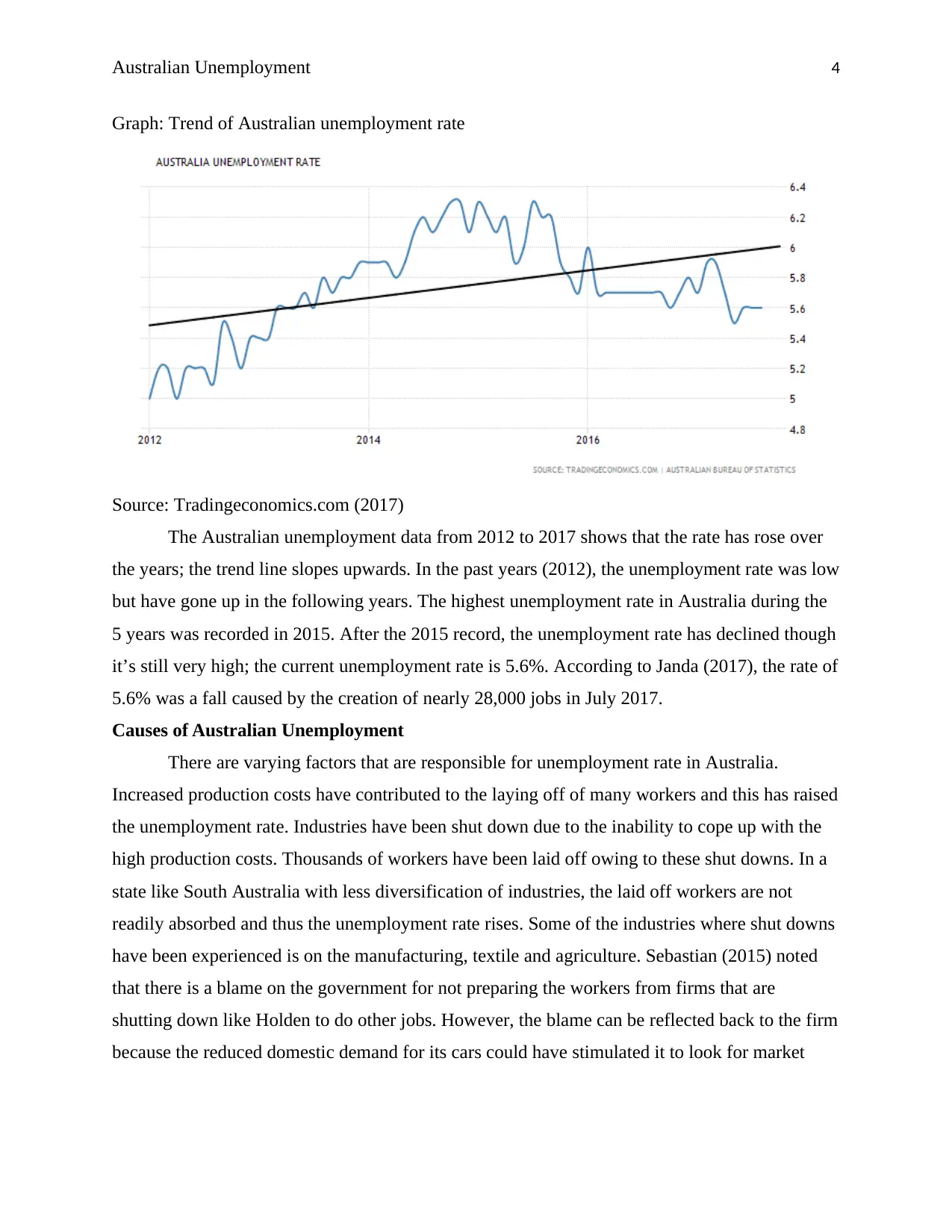
Australian Unemployment 4
Graph: Trend of Australian unemployment rate
Source: Tradingeconomics.com (2017)
The Australian unemployment data from 2012 to 2017 shows that the rate has rose over
the years; the trend line slopes upwards. In the past years (2012), the unemployment rate was low
but have gone up in the following years. The highest unemployment rate in Australia during the
5 years was recorded in 2015. After the 2015 record, the unemployment rate has declined though
it’s still very high; the current unemployment rate is 5.6%. According to Janda (2017), the rate of
5.6% was a fall caused by the creation of nearly 28,000 jobs in July 2017.
Causes of Australian Unemployment
There are varying factors that are responsible for unemployment rate in Australia.
Increased production costs have contributed to the laying off of many workers and this has raised
the unemployment rate. Industries have been shut down due to the inability to cope up with the
high production costs. Thousands of workers have been laid off owing to these shut downs. In a
state like South Australia with less diversification of industries, the laid off workers are not
readily absorbed and thus the unemployment rate rises. Some of the industries where shut downs
have been experienced is on the manufacturing, textile and agriculture. Sebastian (2015) noted
that there is a blame on the government for not preparing the workers from firms that are
shutting down like Holden to do other jobs. However, the blame can be reflected back to the firm
because the reduced domestic demand for its cars could have stimulated it to look for market
Graph: Trend of Australian unemployment rate
Source: Tradingeconomics.com (2017)
The Australian unemployment data from 2012 to 2017 shows that the rate has rose over
the years; the trend line slopes upwards. In the past years (2012), the unemployment rate was low
but have gone up in the following years. The highest unemployment rate in Australia during the
5 years was recorded in 2015. After the 2015 record, the unemployment rate has declined though
it’s still very high; the current unemployment rate is 5.6%. According to Janda (2017), the rate of
5.6% was a fall caused by the creation of nearly 28,000 jobs in July 2017.
Causes of Australian Unemployment
There are varying factors that are responsible for unemployment rate in Australia.
Increased production costs have contributed to the laying off of many workers and this has raised
the unemployment rate. Industries have been shut down due to the inability to cope up with the
high production costs. Thousands of workers have been laid off owing to these shut downs. In a
state like South Australia with less diversification of industries, the laid off workers are not
readily absorbed and thus the unemployment rate rises. Some of the industries where shut downs
have been experienced is on the manufacturing, textile and agriculture. Sebastian (2015) noted
that there is a blame on the government for not preparing the workers from firms that are
shutting down like Holden to do other jobs. However, the blame can be reflected back to the firm
because the reduced domestic demand for its cars could have stimulated it to look for market
Paraphrase This Document
Need a fresh take? Get an instant paraphrase of this document with our AI Paraphraser
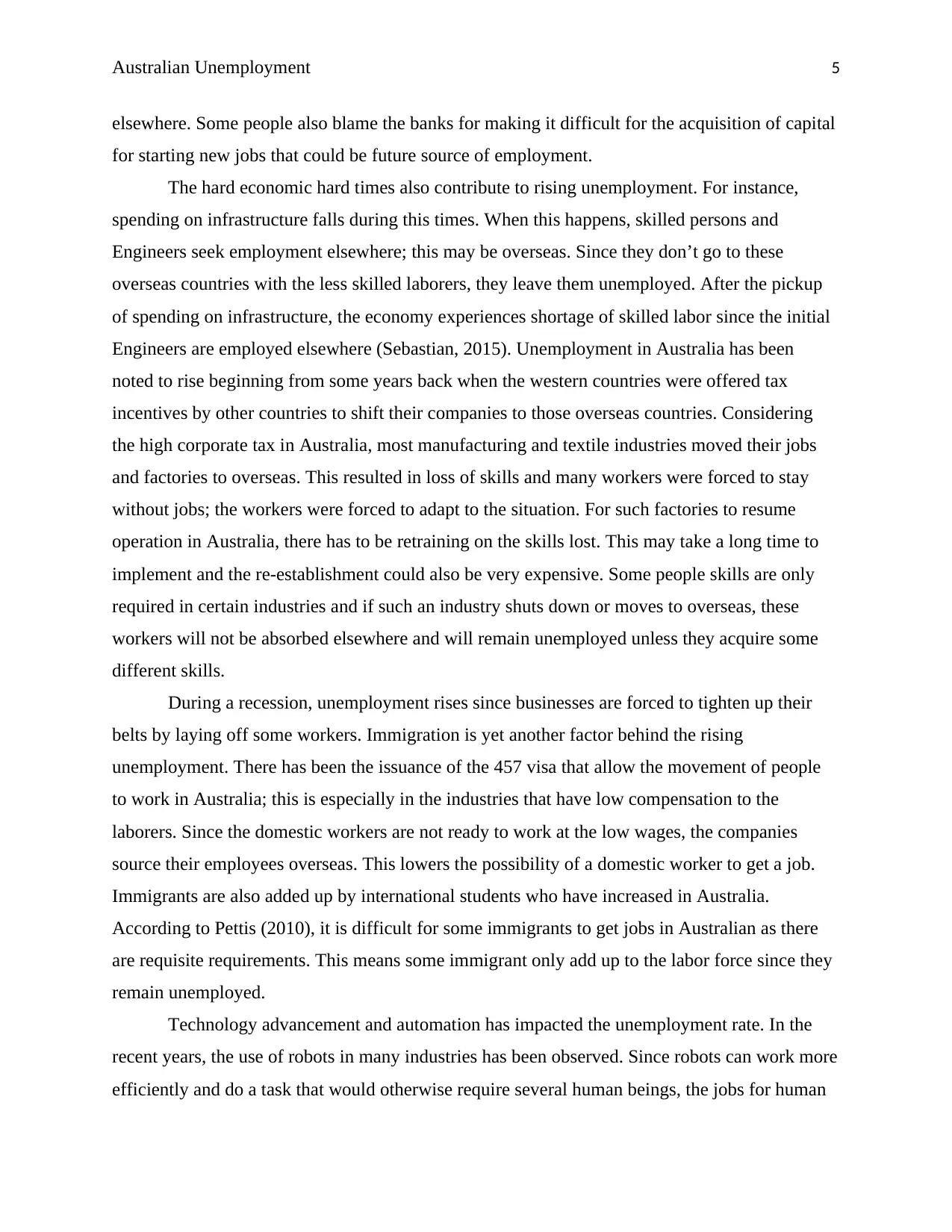
Australian Unemployment 5
elsewhere. Some people also blame the banks for making it difficult for the acquisition of capital
for starting new jobs that could be future source of employment.
The hard economic hard times also contribute to rising unemployment. For instance,
spending on infrastructure falls during this times. When this happens, skilled persons and
Engineers seek employment elsewhere; this may be overseas. Since they don’t go to these
overseas countries with the less skilled laborers, they leave them unemployed. After the pickup
of spending on infrastructure, the economy experiences shortage of skilled labor since the initial
Engineers are employed elsewhere (Sebastian, 2015). Unemployment in Australia has been
noted to rise beginning from some years back when the western countries were offered tax
incentives by other countries to shift their companies to those overseas countries. Considering
the high corporate tax in Australia, most manufacturing and textile industries moved their jobs
and factories to overseas. This resulted in loss of skills and many workers were forced to stay
without jobs; the workers were forced to adapt to the situation. For such factories to resume
operation in Australia, there has to be retraining on the skills lost. This may take a long time to
implement and the re-establishment could also be very expensive. Some people skills are only
required in certain industries and if such an industry shuts down or moves to overseas, these
workers will not be absorbed elsewhere and will remain unemployed unless they acquire some
different skills.
During a recession, unemployment rises since businesses are forced to tighten up their
belts by laying off some workers. Immigration is yet another factor behind the rising
unemployment. There has been the issuance of the 457 visa that allow the movement of people
to work in Australia; this is especially in the industries that have low compensation to the
laborers. Since the domestic workers are not ready to work at the low wages, the companies
source their employees overseas. This lowers the possibility of a domestic worker to get a job.
Immigrants are also added up by international students who have increased in Australia.
According to Pettis (2010), it is difficult for some immigrants to get jobs in Australian as there
are requisite requirements. This means some immigrant only add up to the labor force since they
remain unemployed.
Technology advancement and automation has impacted the unemployment rate. In the
recent years, the use of robots in many industries has been observed. Since robots can work more
efficiently and do a task that would otherwise require several human beings, the jobs for human
elsewhere. Some people also blame the banks for making it difficult for the acquisition of capital
for starting new jobs that could be future source of employment.
The hard economic hard times also contribute to rising unemployment. For instance,
spending on infrastructure falls during this times. When this happens, skilled persons and
Engineers seek employment elsewhere; this may be overseas. Since they don’t go to these
overseas countries with the less skilled laborers, they leave them unemployed. After the pickup
of spending on infrastructure, the economy experiences shortage of skilled labor since the initial
Engineers are employed elsewhere (Sebastian, 2015). Unemployment in Australia has been
noted to rise beginning from some years back when the western countries were offered tax
incentives by other countries to shift their companies to those overseas countries. Considering
the high corporate tax in Australia, most manufacturing and textile industries moved their jobs
and factories to overseas. This resulted in loss of skills and many workers were forced to stay
without jobs; the workers were forced to adapt to the situation. For such factories to resume
operation in Australia, there has to be retraining on the skills lost. This may take a long time to
implement and the re-establishment could also be very expensive. Some people skills are only
required in certain industries and if such an industry shuts down or moves to overseas, these
workers will not be absorbed elsewhere and will remain unemployed unless they acquire some
different skills.
During a recession, unemployment rises since businesses are forced to tighten up their
belts by laying off some workers. Immigration is yet another factor behind the rising
unemployment. There has been the issuance of the 457 visa that allow the movement of people
to work in Australia; this is especially in the industries that have low compensation to the
laborers. Since the domestic workers are not ready to work at the low wages, the companies
source their employees overseas. This lowers the possibility of a domestic worker to get a job.
Immigrants are also added up by international students who have increased in Australia.
According to Pettis (2010), it is difficult for some immigrants to get jobs in Australian as there
are requisite requirements. This means some immigrant only add up to the labor force since they
remain unemployed.
Technology advancement and automation has impacted the unemployment rate. In the
recent years, the use of robots in many industries has been observed. Since robots can work more
efficiently and do a task that would otherwise require several human beings, the jobs for human
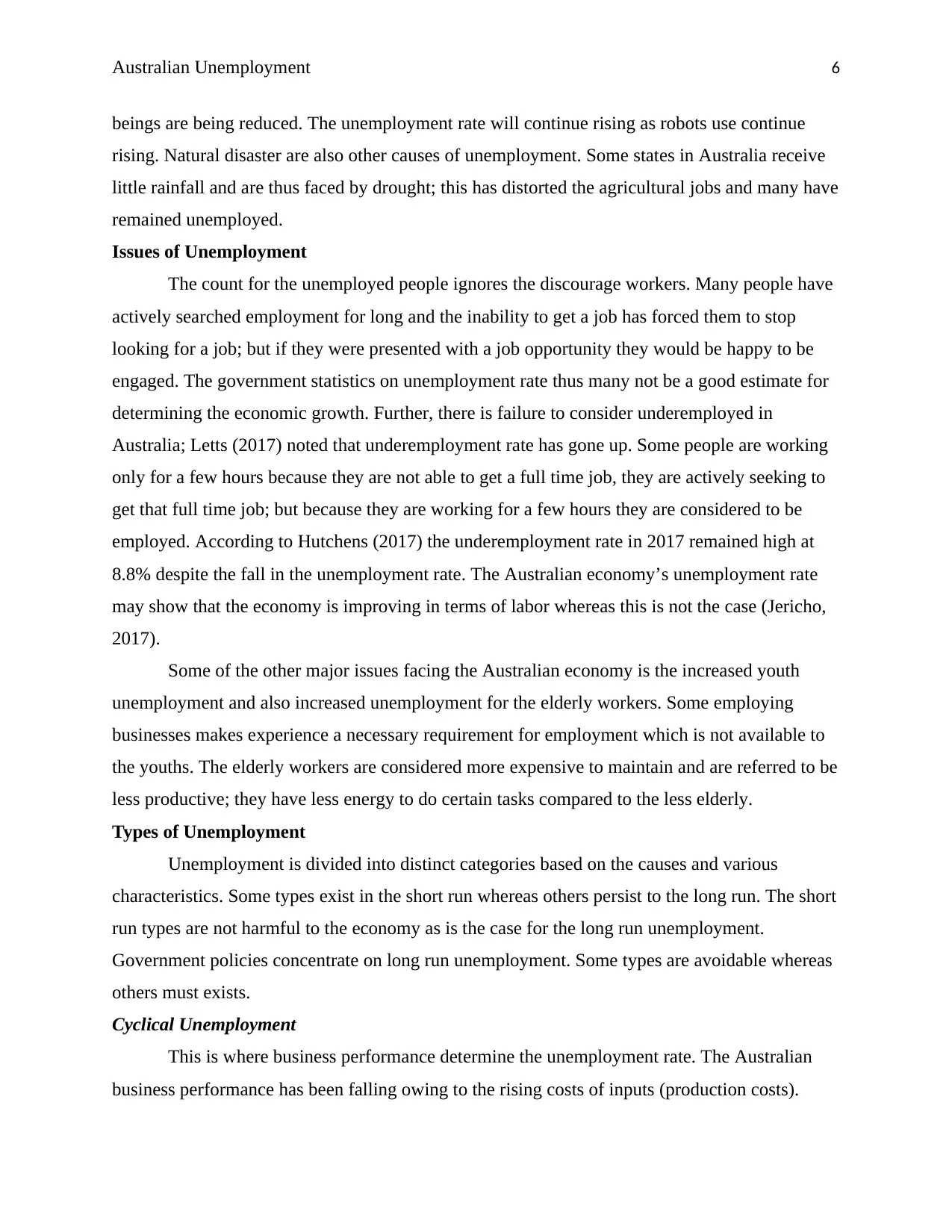
Australian Unemployment 6
beings are being reduced. The unemployment rate will continue rising as robots use continue
rising. Natural disaster are also other causes of unemployment. Some states in Australia receive
little rainfall and are thus faced by drought; this has distorted the agricultural jobs and many have
remained unemployed.
Issues of Unemployment
The count for the unemployed people ignores the discourage workers. Many people have
actively searched employment for long and the inability to get a job has forced them to stop
looking for a job; but if they were presented with a job opportunity they would be happy to be
engaged. The government statistics on unemployment rate thus many not be a good estimate for
determining the economic growth. Further, there is failure to consider underemployed in
Australia; Letts (2017) noted that underemployment rate has gone up. Some people are working
only for a few hours because they are not able to get a full time job, they are actively seeking to
get that full time job; but because they are working for a few hours they are considered to be
employed. According to Hutchens (2017) the underemployment rate in 2017 remained high at
8.8% despite the fall in the unemployment rate. The Australian economy’s unemployment rate
may show that the economy is improving in terms of labor whereas this is not the case (Jericho,
2017).
Some of the other major issues facing the Australian economy is the increased youth
unemployment and also increased unemployment for the elderly workers. Some employing
businesses makes experience a necessary requirement for employment which is not available to
the youths. The elderly workers are considered more expensive to maintain and are referred to be
less productive; they have less energy to do certain tasks compared to the less elderly.
Types of Unemployment
Unemployment is divided into distinct categories based on the causes and various
characteristics. Some types exist in the short run whereas others persist to the long run. The short
run types are not harmful to the economy as is the case for the long run unemployment.
Government policies concentrate on long run unemployment. Some types are avoidable whereas
others must exists.
Cyclical Unemployment
This is where business performance determine the unemployment rate. The Australian
business performance has been falling owing to the rising costs of inputs (production costs).
beings are being reduced. The unemployment rate will continue rising as robots use continue
rising. Natural disaster are also other causes of unemployment. Some states in Australia receive
little rainfall and are thus faced by drought; this has distorted the agricultural jobs and many have
remained unemployed.
Issues of Unemployment
The count for the unemployed people ignores the discourage workers. Many people have
actively searched employment for long and the inability to get a job has forced them to stop
looking for a job; but if they were presented with a job opportunity they would be happy to be
engaged. The government statistics on unemployment rate thus many not be a good estimate for
determining the economic growth. Further, there is failure to consider underemployed in
Australia; Letts (2017) noted that underemployment rate has gone up. Some people are working
only for a few hours because they are not able to get a full time job, they are actively seeking to
get that full time job; but because they are working for a few hours they are considered to be
employed. According to Hutchens (2017) the underemployment rate in 2017 remained high at
8.8% despite the fall in the unemployment rate. The Australian economy’s unemployment rate
may show that the economy is improving in terms of labor whereas this is not the case (Jericho,
2017).
Some of the other major issues facing the Australian economy is the increased youth
unemployment and also increased unemployment for the elderly workers. Some employing
businesses makes experience a necessary requirement for employment which is not available to
the youths. The elderly workers are considered more expensive to maintain and are referred to be
less productive; they have less energy to do certain tasks compared to the less elderly.
Types of Unemployment
Unemployment is divided into distinct categories based on the causes and various
characteristics. Some types exist in the short run whereas others persist to the long run. The short
run types are not harmful to the economy as is the case for the long run unemployment.
Government policies concentrate on long run unemployment. Some types are avoidable whereas
others must exists.
Cyclical Unemployment
This is where business performance determine the unemployment rate. The Australian
business performance has been falling owing to the rising costs of inputs (production costs).
⊘ This is a preview!⊘
Do you want full access?
Subscribe today to unlock all pages.

Trusted by 1+ million students worldwide
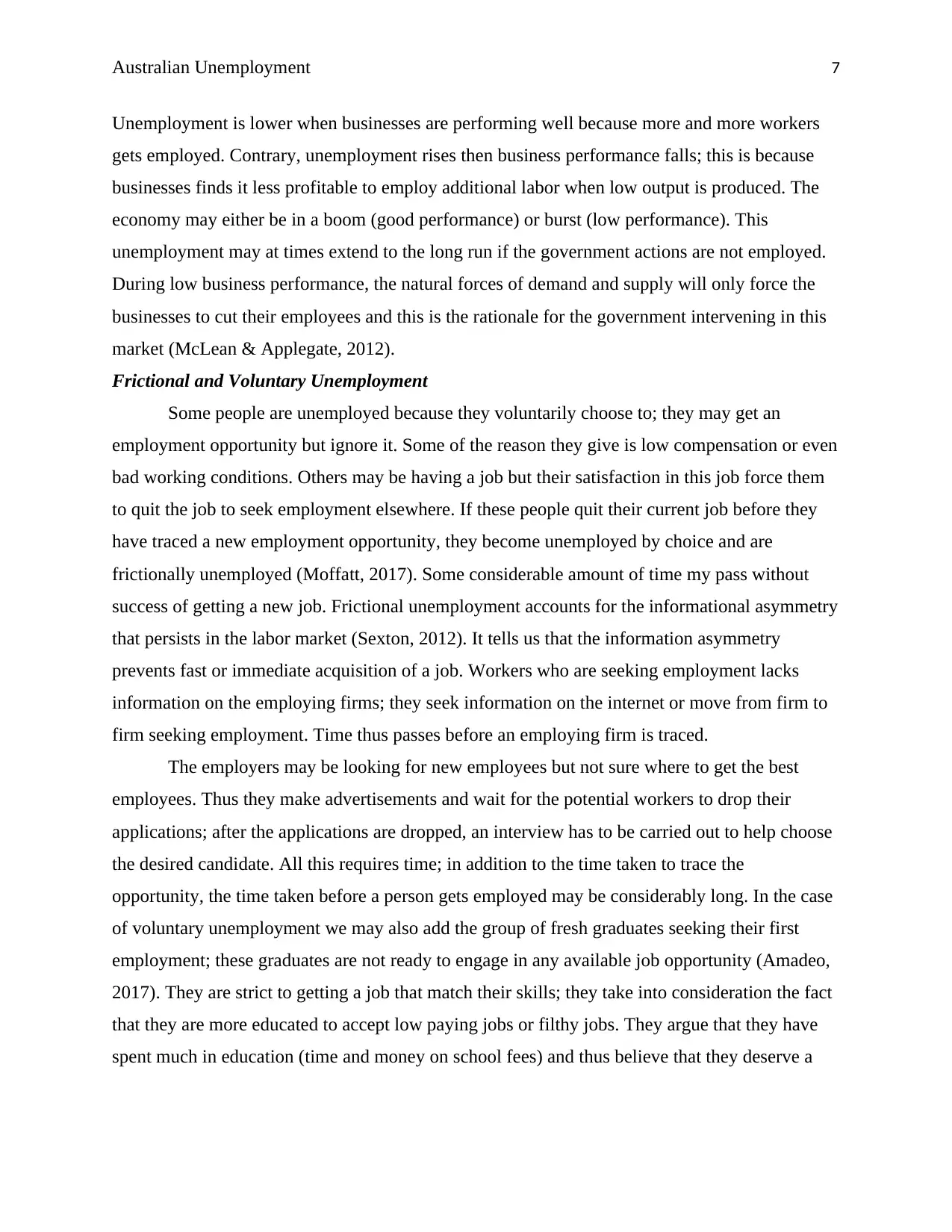
Australian Unemployment 7
Unemployment is lower when businesses are performing well because more and more workers
gets employed. Contrary, unemployment rises then business performance falls; this is because
businesses finds it less profitable to employ additional labor when low output is produced. The
economy may either be in a boom (good performance) or burst (low performance). This
unemployment may at times extend to the long run if the government actions are not employed.
During low business performance, the natural forces of demand and supply will only force the
businesses to cut their employees and this is the rationale for the government intervening in this
market (McLean & Applegate, 2012).
Frictional and Voluntary Unemployment
Some people are unemployed because they voluntarily choose to; they may get an
employment opportunity but ignore it. Some of the reason they give is low compensation or even
bad working conditions. Others may be having a job but their satisfaction in this job force them
to quit the job to seek employment elsewhere. If these people quit their current job before they
have traced a new employment opportunity, they become unemployed by choice and are
frictionally unemployed (Moffatt, 2017). Some considerable amount of time my pass without
success of getting a new job. Frictional unemployment accounts for the informational asymmetry
that persists in the labor market (Sexton, 2012). It tells us that the information asymmetry
prevents fast or immediate acquisition of a job. Workers who are seeking employment lacks
information on the employing firms; they seek information on the internet or move from firm to
firm seeking employment. Time thus passes before an employing firm is traced.
The employers may be looking for new employees but not sure where to get the best
employees. Thus they make advertisements and wait for the potential workers to drop their
applications; after the applications are dropped, an interview has to be carried out to help choose
the desired candidate. All this requires time; in addition to the time taken to trace the
opportunity, the time taken before a person gets employed may be considerably long. In the case
of voluntary unemployment we may also add the group of fresh graduates seeking their first
employment; these graduates are not ready to engage in any available job opportunity (Amadeo,
2017). They are strict to getting a job that match their skills; they take into consideration the fact
that they are more educated to accept low paying jobs or filthy jobs. They argue that they have
spent much in education (time and money on school fees) and thus believe that they deserve a
Unemployment is lower when businesses are performing well because more and more workers
gets employed. Contrary, unemployment rises then business performance falls; this is because
businesses finds it less profitable to employ additional labor when low output is produced. The
economy may either be in a boom (good performance) or burst (low performance). This
unemployment may at times extend to the long run if the government actions are not employed.
During low business performance, the natural forces of demand and supply will only force the
businesses to cut their employees and this is the rationale for the government intervening in this
market (McLean & Applegate, 2012).
Frictional and Voluntary Unemployment
Some people are unemployed because they voluntarily choose to; they may get an
employment opportunity but ignore it. Some of the reason they give is low compensation or even
bad working conditions. Others may be having a job but their satisfaction in this job force them
to quit the job to seek employment elsewhere. If these people quit their current job before they
have traced a new employment opportunity, they become unemployed by choice and are
frictionally unemployed (Moffatt, 2017). Some considerable amount of time my pass without
success of getting a new job. Frictional unemployment accounts for the informational asymmetry
that persists in the labor market (Sexton, 2012). It tells us that the information asymmetry
prevents fast or immediate acquisition of a job. Workers who are seeking employment lacks
information on the employing firms; they seek information on the internet or move from firm to
firm seeking employment. Time thus passes before an employing firm is traced.
The employers may be looking for new employees but not sure where to get the best
employees. Thus they make advertisements and wait for the potential workers to drop their
applications; after the applications are dropped, an interview has to be carried out to help choose
the desired candidate. All this requires time; in addition to the time taken to trace the
opportunity, the time taken before a person gets employed may be considerably long. In the case
of voluntary unemployment we may also add the group of fresh graduates seeking their first
employment; these graduates are not ready to engage in any available job opportunity (Amadeo,
2017). They are strict to getting a job that match their skills; they take into consideration the fact
that they are more educated to accept low paying jobs or filthy jobs. They argue that they have
spent much in education (time and money on school fees) and thus believe that they deserve a
Paraphrase This Document
Need a fresh take? Get an instant paraphrase of this document with our AI Paraphraser
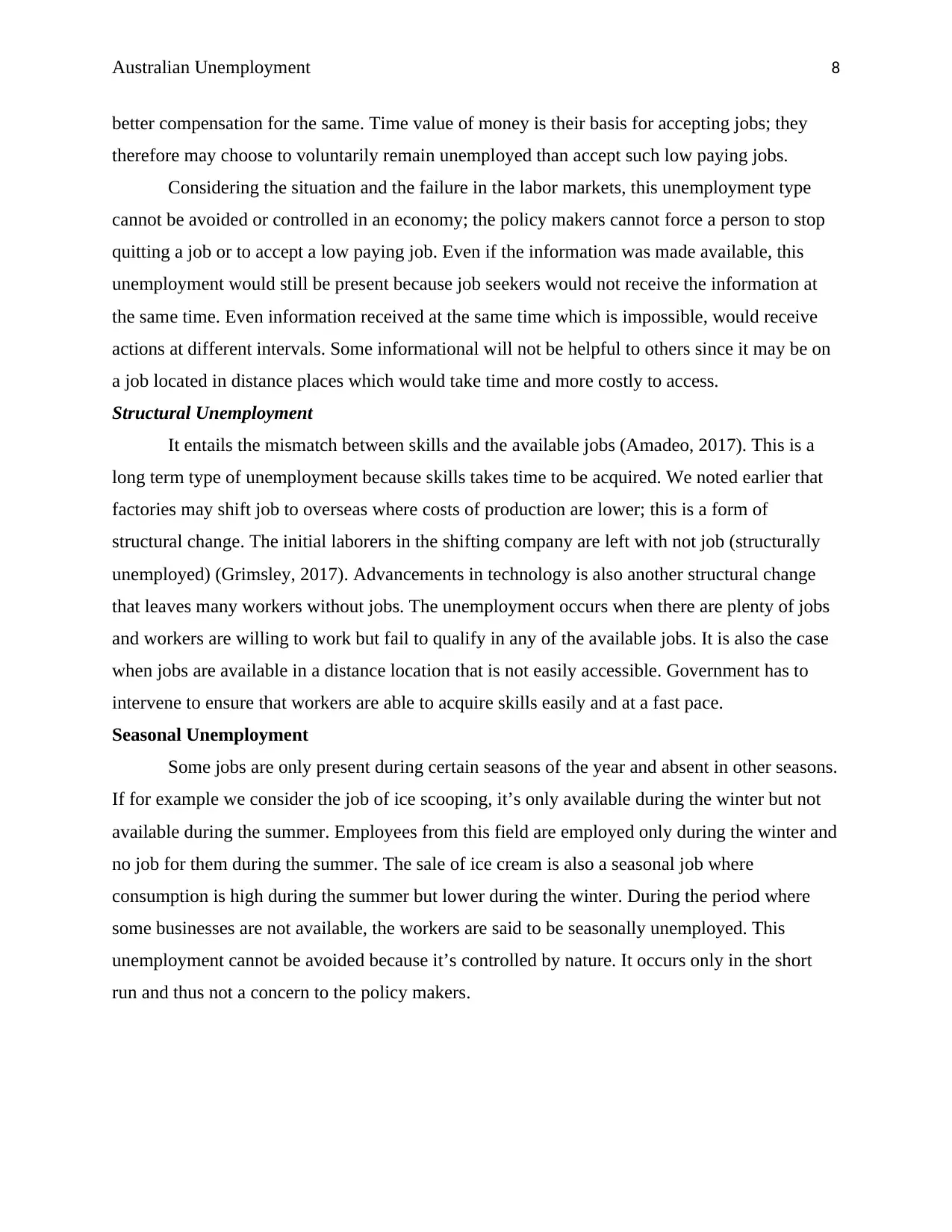
Australian Unemployment 8
better compensation for the same. Time value of money is their basis for accepting jobs; they
therefore may choose to voluntarily remain unemployed than accept such low paying jobs.
Considering the situation and the failure in the labor markets, this unemployment type
cannot be avoided or controlled in an economy; the policy makers cannot force a person to stop
quitting a job or to accept a low paying job. Even if the information was made available, this
unemployment would still be present because job seekers would not receive the information at
the same time. Even information received at the same time which is impossible, would receive
actions at different intervals. Some informational will not be helpful to others since it may be on
a job located in distance places which would take time and more costly to access.
Structural Unemployment
It entails the mismatch between skills and the available jobs (Amadeo, 2017). This is a
long term type of unemployment because skills takes time to be acquired. We noted earlier that
factories may shift job to overseas where costs of production are lower; this is a form of
structural change. The initial laborers in the shifting company are left with not job (structurally
unemployed) (Grimsley, 2017). Advancements in technology is also another structural change
that leaves many workers without jobs. The unemployment occurs when there are plenty of jobs
and workers are willing to work but fail to qualify in any of the available jobs. It is also the case
when jobs are available in a distance location that is not easily accessible. Government has to
intervene to ensure that workers are able to acquire skills easily and at a fast pace.
Seasonal Unemployment
Some jobs are only present during certain seasons of the year and absent in other seasons.
If for example we consider the job of ice scooping, it’s only available during the winter but not
available during the summer. Employees from this field are employed only during the winter and
no job for them during the summer. The sale of ice cream is also a seasonal job where
consumption is high during the summer but lower during the winter. During the period where
some businesses are not available, the workers are said to be seasonally unemployed. This
unemployment cannot be avoided because it’s controlled by nature. It occurs only in the short
run and thus not a concern to the policy makers.
better compensation for the same. Time value of money is their basis for accepting jobs; they
therefore may choose to voluntarily remain unemployed than accept such low paying jobs.
Considering the situation and the failure in the labor markets, this unemployment type
cannot be avoided or controlled in an economy; the policy makers cannot force a person to stop
quitting a job or to accept a low paying job. Even if the information was made available, this
unemployment would still be present because job seekers would not receive the information at
the same time. Even information received at the same time which is impossible, would receive
actions at different intervals. Some informational will not be helpful to others since it may be on
a job located in distance places which would take time and more costly to access.
Structural Unemployment
It entails the mismatch between skills and the available jobs (Amadeo, 2017). This is a
long term type of unemployment because skills takes time to be acquired. We noted earlier that
factories may shift job to overseas where costs of production are lower; this is a form of
structural change. The initial laborers in the shifting company are left with not job (structurally
unemployed) (Grimsley, 2017). Advancements in technology is also another structural change
that leaves many workers without jobs. The unemployment occurs when there are plenty of jobs
and workers are willing to work but fail to qualify in any of the available jobs. It is also the case
when jobs are available in a distance location that is not easily accessible. Government has to
intervene to ensure that workers are able to acquire skills easily and at a fast pace.
Seasonal Unemployment
Some jobs are only present during certain seasons of the year and absent in other seasons.
If for example we consider the job of ice scooping, it’s only available during the winter but not
available during the summer. Employees from this field are employed only during the winter and
no job for them during the summer. The sale of ice cream is also a seasonal job where
consumption is high during the summer but lower during the winter. During the period where
some businesses are not available, the workers are said to be seasonally unemployed. This
unemployment cannot be avoided because it’s controlled by nature. It occurs only in the short
run and thus not a concern to the policy makers.
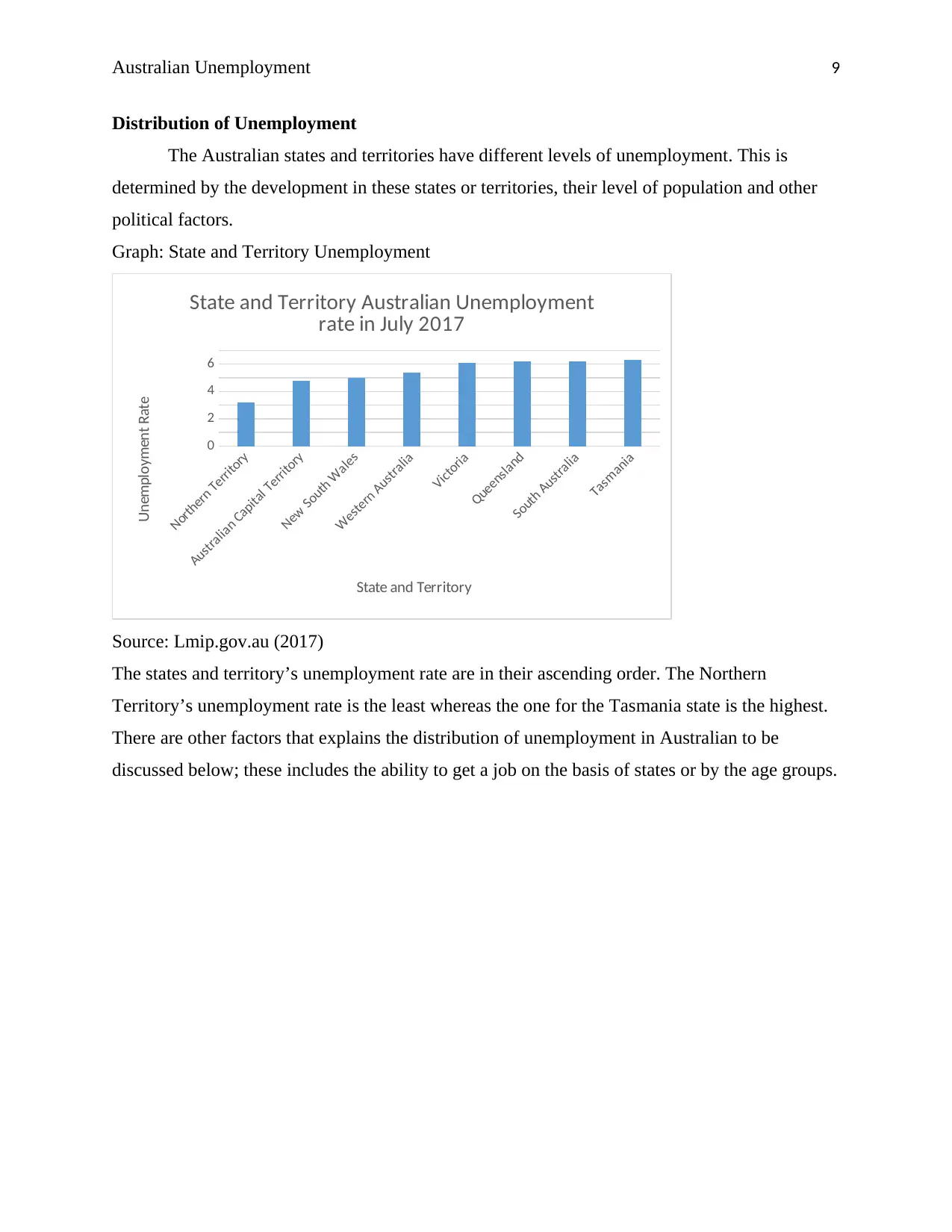
Australian Unemployment 9
Distribution of Unemployment
The Australian states and territories have different levels of unemployment. This is
determined by the development in these states or territories, their level of population and other
political factors.
Graph: State and Territory Unemployment
Northern Territory
Australian Capital Territory
New South Wales
Western Australia
Victoria
Queensland
South Australia
Tasmania
0
2
4
6
State and Territory Australian Unemployment
rate in July 2017
State and Territory
Unemployment Rate
Source: Lmip.gov.au (2017)
The states and territory’s unemployment rate are in their ascending order. The Northern
Territory’s unemployment rate is the least whereas the one for the Tasmania state is the highest.
There are other factors that explains the distribution of unemployment in Australian to be
discussed below; these includes the ability to get a job on the basis of states or by the age groups.
Distribution of Unemployment
The Australian states and territories have different levels of unemployment. This is
determined by the development in these states or territories, their level of population and other
political factors.
Graph: State and Territory Unemployment
Northern Territory
Australian Capital Territory
New South Wales
Western Australia
Victoria
Queensland
South Australia
Tasmania
0
2
4
6
State and Territory Australian Unemployment
rate in July 2017
State and Territory
Unemployment Rate
Source: Lmip.gov.au (2017)
The states and territory’s unemployment rate are in their ascending order. The Northern
Territory’s unemployment rate is the least whereas the one for the Tasmania state is the highest.
There are other factors that explains the distribution of unemployment in Australian to be
discussed below; these includes the ability to get a job on the basis of states or by the age groups.
⊘ This is a preview!⊘
Do you want full access?
Subscribe today to unlock all pages.

Trusted by 1+ million students worldwide
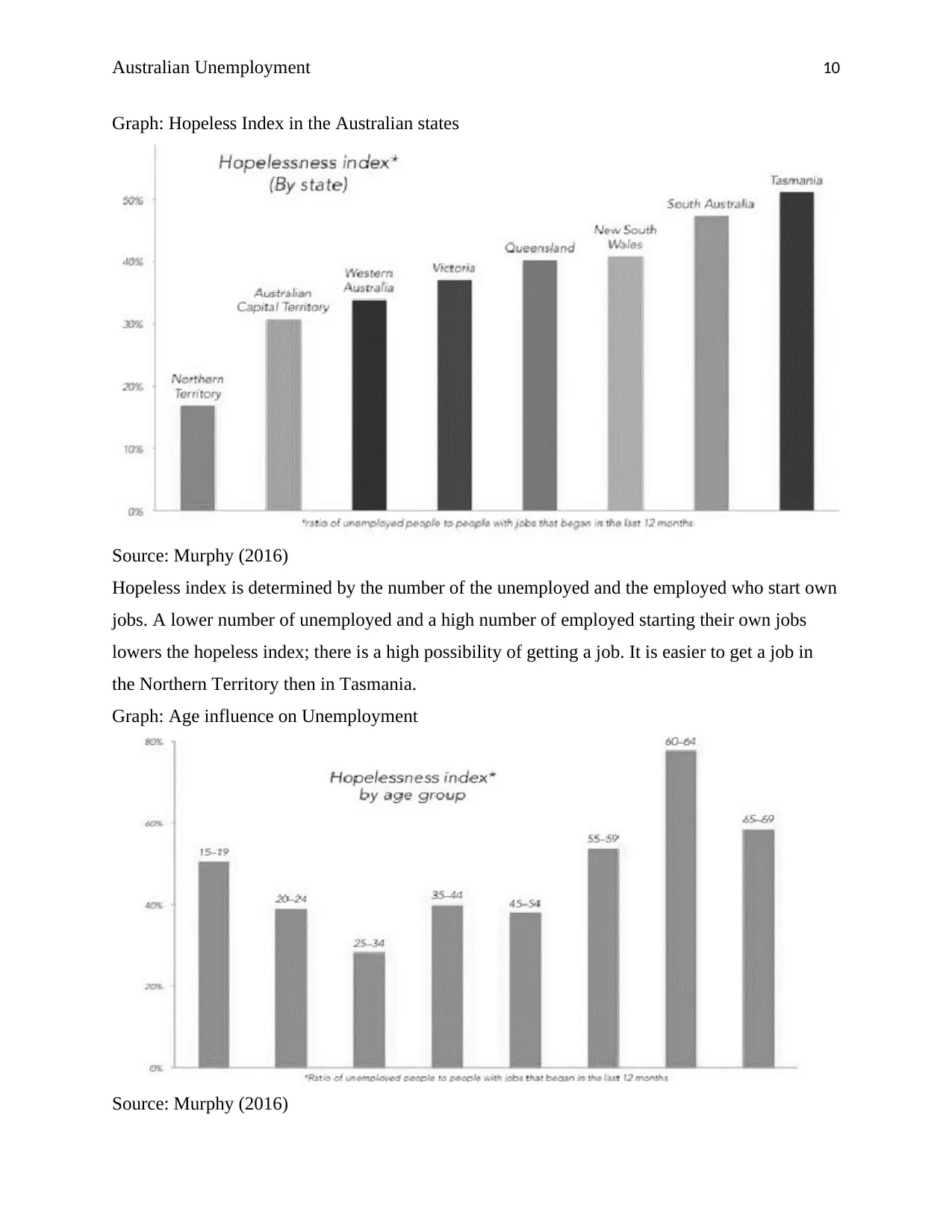
Australian Unemployment 10
Graph: Hopeless Index in the Australian states
Source: Murphy (2016)
Hopeless index is determined by the number of the unemployed and the employed who start own
jobs. A lower number of unemployed and a high number of employed starting their own jobs
lowers the hopeless index; there is a high possibility of getting a job. It is easier to get a job in
the Northern Territory then in Tasmania.
Graph: Age influence on Unemployment
Source: Murphy (2016)
Graph: Hopeless Index in the Australian states
Source: Murphy (2016)
Hopeless index is determined by the number of the unemployed and the employed who start own
jobs. A lower number of unemployed and a high number of employed starting their own jobs
lowers the hopeless index; there is a high possibility of getting a job. It is easier to get a job in
the Northern Territory then in Tasmania.
Graph: Age influence on Unemployment
Source: Murphy (2016)
Paraphrase This Document
Need a fresh take? Get an instant paraphrase of this document with our AI Paraphraser
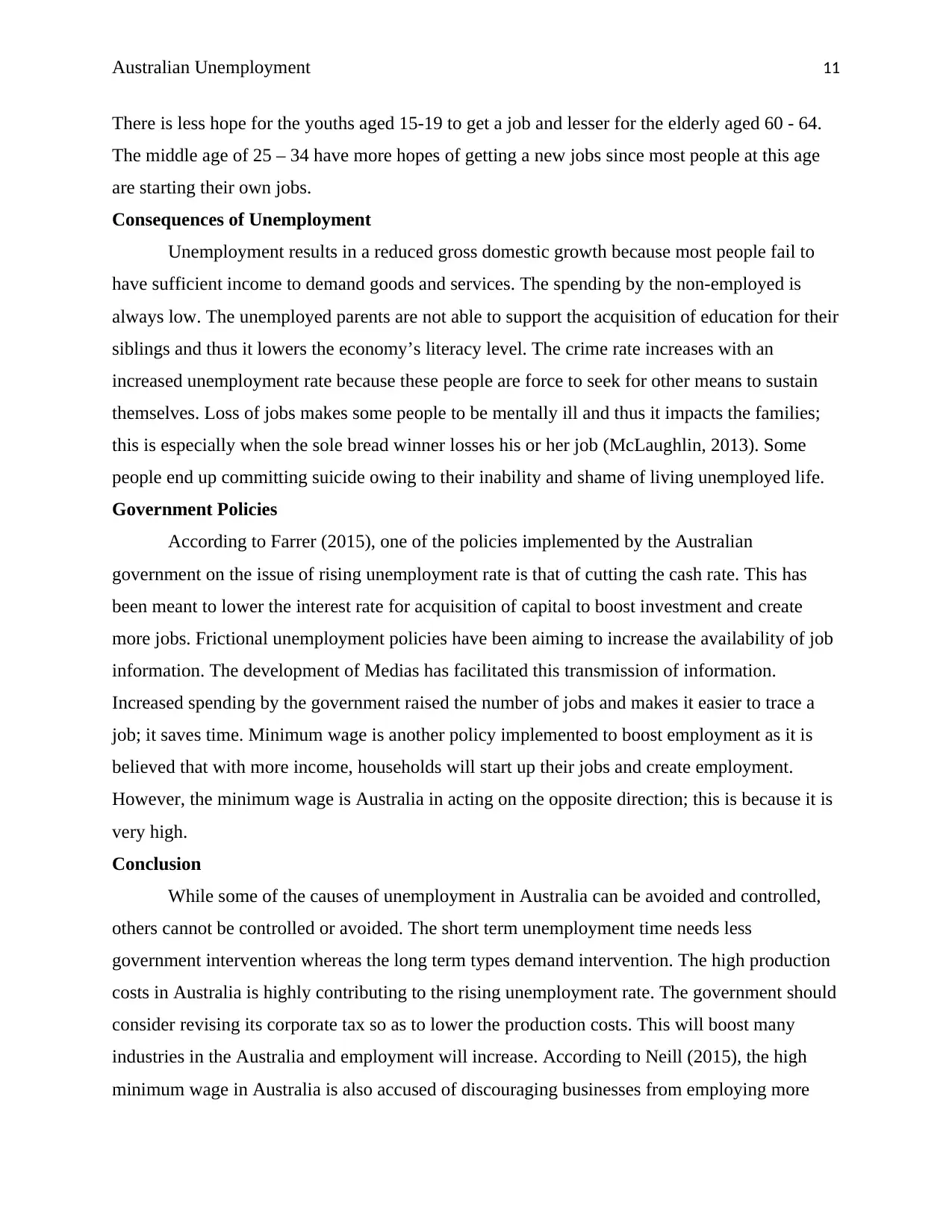
Australian Unemployment 11
There is less hope for the youths aged 15-19 to get a job and lesser for the elderly aged 60 - 64.
The middle age of 25 – 34 have more hopes of getting a new jobs since most people at this age
are starting their own jobs.
Consequences of Unemployment
Unemployment results in a reduced gross domestic growth because most people fail to
have sufficient income to demand goods and services. The spending by the non-employed is
always low. The unemployed parents are not able to support the acquisition of education for their
siblings and thus it lowers the economy’s literacy level. The crime rate increases with an
increased unemployment rate because these people are force to seek for other means to sustain
themselves. Loss of jobs makes some people to be mentally ill and thus it impacts the families;
this is especially when the sole bread winner losses his or her job (McLaughlin, 2013). Some
people end up committing suicide owing to their inability and shame of living unemployed life.
Government Policies
According to Farrer (2015), one of the policies implemented by the Australian
government on the issue of rising unemployment rate is that of cutting the cash rate. This has
been meant to lower the interest rate for acquisition of capital to boost investment and create
more jobs. Frictional unemployment policies have been aiming to increase the availability of job
information. The development of Medias has facilitated this transmission of information.
Increased spending by the government raised the number of jobs and makes it easier to trace a
job; it saves time. Minimum wage is another policy implemented to boost employment as it is
believed that with more income, households will start up their jobs and create employment.
However, the minimum wage is Australia in acting on the opposite direction; this is because it is
very high.
Conclusion
While some of the causes of unemployment in Australia can be avoided and controlled,
others cannot be controlled or avoided. The short term unemployment time needs less
government intervention whereas the long term types demand intervention. The high production
costs in Australia is highly contributing to the rising unemployment rate. The government should
consider revising its corporate tax so as to lower the production costs. This will boost many
industries in the Australia and employment will increase. According to Neill (2015), the high
minimum wage in Australia is also accused of discouraging businesses from employing more
There is less hope for the youths aged 15-19 to get a job and lesser for the elderly aged 60 - 64.
The middle age of 25 – 34 have more hopes of getting a new jobs since most people at this age
are starting their own jobs.
Consequences of Unemployment
Unemployment results in a reduced gross domestic growth because most people fail to
have sufficient income to demand goods and services. The spending by the non-employed is
always low. The unemployed parents are not able to support the acquisition of education for their
siblings and thus it lowers the economy’s literacy level. The crime rate increases with an
increased unemployment rate because these people are force to seek for other means to sustain
themselves. Loss of jobs makes some people to be mentally ill and thus it impacts the families;
this is especially when the sole bread winner losses his or her job (McLaughlin, 2013). Some
people end up committing suicide owing to their inability and shame of living unemployed life.
Government Policies
According to Farrer (2015), one of the policies implemented by the Australian
government on the issue of rising unemployment rate is that of cutting the cash rate. This has
been meant to lower the interest rate for acquisition of capital to boost investment and create
more jobs. Frictional unemployment policies have been aiming to increase the availability of job
information. The development of Medias has facilitated this transmission of information.
Increased spending by the government raised the number of jobs and makes it easier to trace a
job; it saves time. Minimum wage is another policy implemented to boost employment as it is
believed that with more income, households will start up their jobs and create employment.
However, the minimum wage is Australia in acting on the opposite direction; this is because it is
very high.
Conclusion
While some of the causes of unemployment in Australia can be avoided and controlled,
others cannot be controlled or avoided. The short term unemployment time needs less
government intervention whereas the long term types demand intervention. The high production
costs in Australia is highly contributing to the rising unemployment rate. The government should
consider revising its corporate tax so as to lower the production costs. This will boost many
industries in the Australia and employment will increase. According to Neill (2015), the high
minimum wage in Australia is also accused of discouraging businesses from employing more
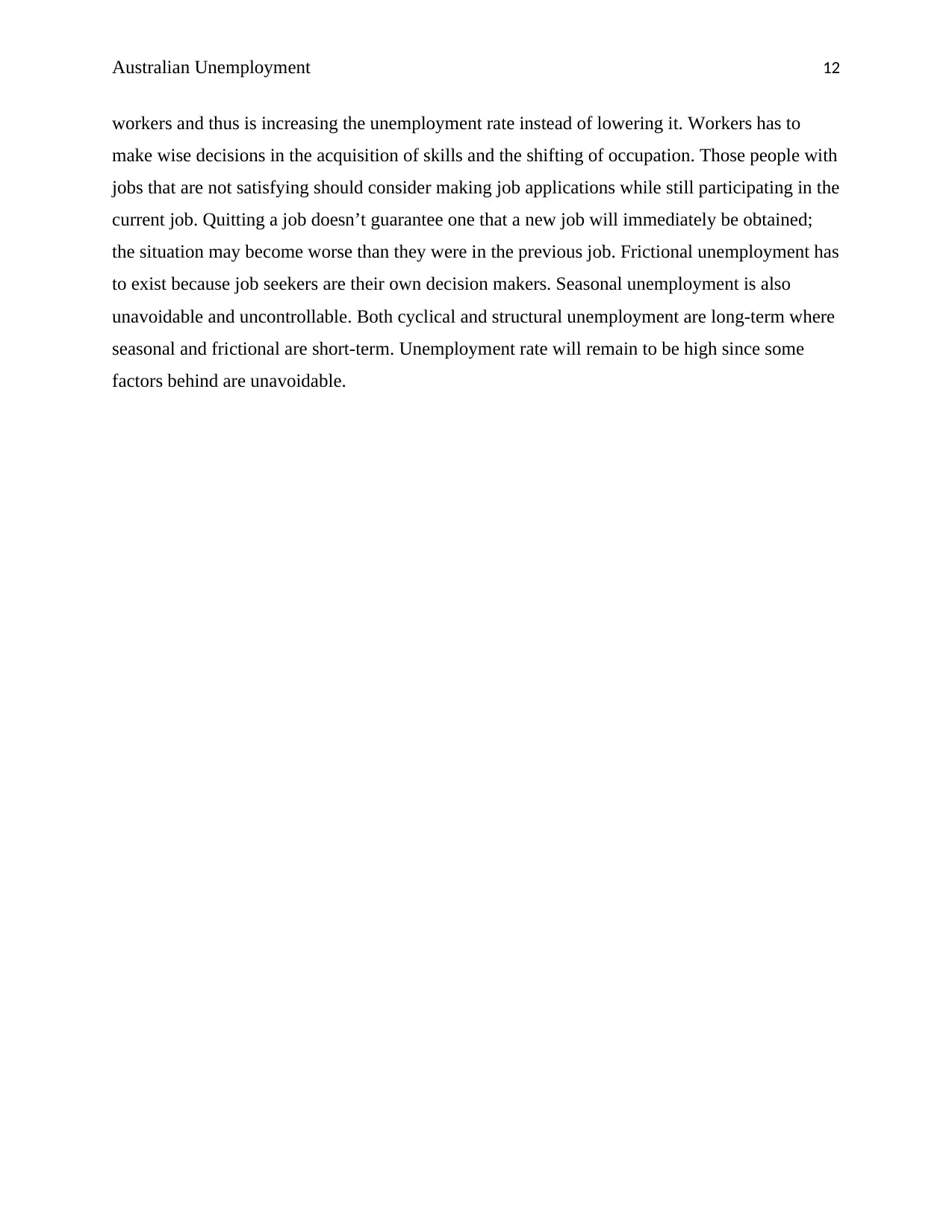
Australian Unemployment 12
workers and thus is increasing the unemployment rate instead of lowering it. Workers has to
make wise decisions in the acquisition of skills and the shifting of occupation. Those people with
jobs that are not satisfying should consider making job applications while still participating in the
current job. Quitting a job doesn’t guarantee one that a new job will immediately be obtained;
the situation may become worse than they were in the previous job. Frictional unemployment has
to exist because job seekers are their own decision makers. Seasonal unemployment is also
unavoidable and uncontrollable. Both cyclical and structural unemployment are long-term where
seasonal and frictional are short-term. Unemployment rate will remain to be high since some
factors behind are unavoidable.
workers and thus is increasing the unemployment rate instead of lowering it. Workers has to
make wise decisions in the acquisition of skills and the shifting of occupation. Those people with
jobs that are not satisfying should consider making job applications while still participating in the
current job. Quitting a job doesn’t guarantee one that a new job will immediately be obtained;
the situation may become worse than they were in the previous job. Frictional unemployment has
to exist because job seekers are their own decision makers. Seasonal unemployment is also
unavoidable and uncontrollable. Both cyclical and structural unemployment are long-term where
seasonal and frictional are short-term. Unemployment rate will remain to be high since some
factors behind are unavoidable.
⊘ This is a preview!⊘
Do you want full access?
Subscribe today to unlock all pages.

Trusted by 1+ million students worldwide
1 out of 14
Related Documents
Your All-in-One AI-Powered Toolkit for Academic Success.
+13062052269
info@desklib.com
Available 24*7 on WhatsApp / Email
![[object Object]](/_next/static/media/star-bottom.7253800d.svg)
Unlock your academic potential
Copyright © 2020–2025 A2Z Services. All Rights Reserved. Developed and managed by ZUCOL.





